Transporter Bridge - Artist Impression
 Photo reference number: 1778
Photo reference number: 1778
Postcard: Greenland & Sons, Newport, Mon.
Naïve picture to give an impression of the bridge before it was completed.
The message on the reverse is fun, though... it predates the poem 'Disobedience' by A.A. Milne but has some similarity.
Passive resistance, also known as nonviolent resistance, is/was the notion of using protesting and other nonviolent means to achieve a political or social goal.
I can't quite make out the phrase on the last but one line: "at some *.*.*.*. *** or", could the three letter word be "oak"?
With regard to a "Passive Resisters sale," I found this article in the Portsmouth Evening News, June 18th 1904:
Today a large crowd gathered at the Oddfellow's Hall at Sandown for the sale of goods confiscated from local passive resisters. The goods put up for sale were mostly watches and chains. The day before, a sale had taken place at the Market House Ventnor where the property on offer included that of the Revd. R. Allen Davies, the congregational minister and resister, comprising a biscuit box and a loo table that sold for £2. A brass-bound writing desk with inscription, belonging to the Revd. J. Howen Rodda (a Bible Christian) was bought for £1 by Mr W. Roff, while a music cabinet and silk screen, the property of Miss James, was bought by the Revd. G. Standing for £1. Outside the Market House, the resisters made speeches, having been refused permission to enter the building. The passive resisters were non-violent protesters who, as a way of rebellion, refused to pay their rates. The protest was mostly by Nonconformist ministers against the introduction of the 1902 Education Act that funded only Church of England and a few Roman Catholic schools. Nationally, nearly 200 protestors found themselves in prison.